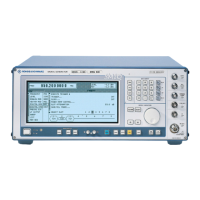SMIQ Digital Standard PDC
1125.5555.03 E-92.279
2.17 Digital Standard PDC
With the options Modulation Coder (SMIQB20) and Data Generator (SMIQB11) provided, modulation
signals according to the Japanese PDC standard
1
can be generated. PDC is a TDMA standard for
cellular mobile radio networks.
SMIQ can generate both the transmit signal of a base station (BS) and the transmit signal of a mobile
station (MS). Transmission from BS to MS is called "downlink", "uplink" being used for transmission in
the opposite direction.
Each TDMA frame consists of 6 slots. The 6 slots can be configured for both full rate and half rate
mode. For half rate, the data content for each of the 6 slots can be defined separately by means of a
slot editor whereas in the full rate mode 2 slots for example slot 1 and 4 are combined in a frame. The
settings for the first slot are then automatically used for the assigned second slot. Each slot can be
switched on or off. Moreover, a defined intermediate level can be set for uplink slots.
A burst type has to be defined to configure a slot. The following burst types can be selected:
• TCH a traffic channel burst with a different structure for uplink and downlink,
• SYNC a burst type for simulation of a sync channel,
• VOX a burst type which is only available in uplink for simulating a communication channel
in speech intervals,
• ALL_DATA burst type for test purposes with freely programmable data contents in the selected
slot.
For TCH and VOX bursts, SMIQ supports the generation of superframes with a length of 18 frames.
The frame position of the so-called "housekeeping channel" RCH can be set in the superframe.
According to the standard, the beginning of the superframe is marked by a special sync word in the
SYNC data field of the first slot.
The following internal modulation sources are available:
• different PRBS generators with a sequence length between 2
9
-1 and 2
23
-1 and
• data lists, ie freely programmable data sequences from the data generator memory.
For generating the PDC signals, SMIQ inserts the modulation data continuously (in real time) into the
selected slots. Using a digital signal processor the data generator generates a data sequence with
modulation data and control signals for envelope control.
The data generator in SMIQ generates a data stream which is converted into IQ signals in the
modulation coder. According to the PDC standard, the modulation type is π/4 DQPSK at a symbol rate
of 21 ksymbol/s and √COS filtering. Symbol rate and filtering can be changed in SMIQ.
1
Personal Digital Cellular Telecommunication System, RCR STD-27 D

